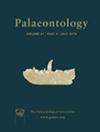整个新生代哺乳动物肢骨的形态差异:生物和非生物因素的作用
IF 2.3
2区 地球科学
Q1 PALEONTOLOGY
引用次数: 0
摘要
哺乳动物的长骨形态表现出与生态相关的多样性,揭示了类群内部和类群之间的广泛适应性。它们在颅后形态上占据独特的生态位被认为是在不同的时间阶段发生的,与非生物因素(如气候和主要类群之间的生物相互作用)有关。哺乳动物的形态在整个新生代迅速演化,几个类群在运动适应方面走了不同的道路。我们对现存和化石大型哺乳动物支系(主要是食肉动物和有蹄类动物)肢体比例的形态变化进行了评估,以检验其与生态适应的关系,并确定其多样化的时间模式。物种之间的系统发育关系被纳入肢骨比例的分析中,显示出与物种底质偏好有关的显著形态变化。大的气候事件似乎对支系或生态群落中以形态差异表示的形态多样化模式没有时间上的影响。线性随机微分方程支持肉食性支系("Creodonta "和食肉目)肢体比例的双刃多样化模式。在整个新生代,食肉目和有齿目形态差异的同时增加,对长脚类的差异产生了显著影响,支持生物相互作用是哺乳动物形态多样化的主要驱动力。我们的研究结果挑战了非生物因素是大型陆生哺乳动物颅后形态进化的主要驱动力这一经典观点,并提出支系竞争是时间分化的关键因素。本文章由计算机程序翻译,如有差异,请以英文原文为准。
Morphological disparity of mammalian limb bones throughout the Cenozoic: the role of biotic and abiotic factors
Mammals exhibit ecology‐related diversity in long bone morphology, revealing an ample spectrum of adaptations both within and between clades. Their occupation of unique ecological niches in postcranial morphology is thought to have occurred at different chronological phases in relation to abiotic factors such as climate and biotic interactions amongst major clades. Mammalian morphologies rapidly evolved throughout the Cenozoic, with several orders following different paths in locomotory adaptations. We assessed morphological variation in limb proportions for a rich sample of extant and fossil large mammalian clades (mainly carnivores and ungulates) to test associations with ecological adaptations and to identify temporal patterns of diversification. Phylogenetic relationships among species were incorporated into the analysis of limb bone proportions, showing significant morphological changes in relation to species substrate preference. Major climatic events appeared to have no temporal impact on patterns of morphological diversification, expressed as morphological disparity, in either clades or ecological groups. Linear stochastic differential equations supported a double‐wedge diversification model for limb proportions of carnivorous clades (‘Creodonta’ and Carnivora). The concomitant increase in morphological disparity throughout the Cenozoic for the orders Carnivora and Artiodactyla had a significative impact on the disparity of Perissodactyla supporting biotic interaction as primary driver of mammalian morphological diversification. Our findings challenge the classic idea of abiotic factors as primary driving forces in the evolution of postcranial morphologies for large terrestrial mammals, and propose clade competition as a key factor in temporal diversification.
求助全文
通过发布文献求助,成功后即可免费获取论文全文。
去求助
来源期刊

Palaeontology
地学-古生物学
CiteScore
5.60
自引率
3.80%
发文量
43
审稿时长
6 months
期刊介绍:
Palaeontology publishes a wide variety of papers on palaeontological topics covering:
palaeozoology
palaeobotany
systematic studies
palaeoecology
micropalaeontology
palaeobiogeography
functional morphology
stratigraphy
taxonomy
taphonomy
palaeoenvironmental reconstruction
palaeoclimate analysis and biomineralization studies.
 求助内容:
求助内容: 应助结果提醒方式:
应助结果提醒方式:


